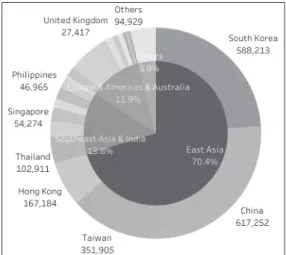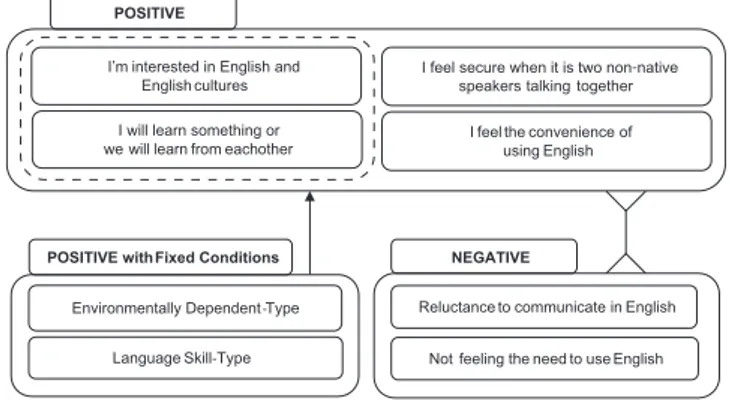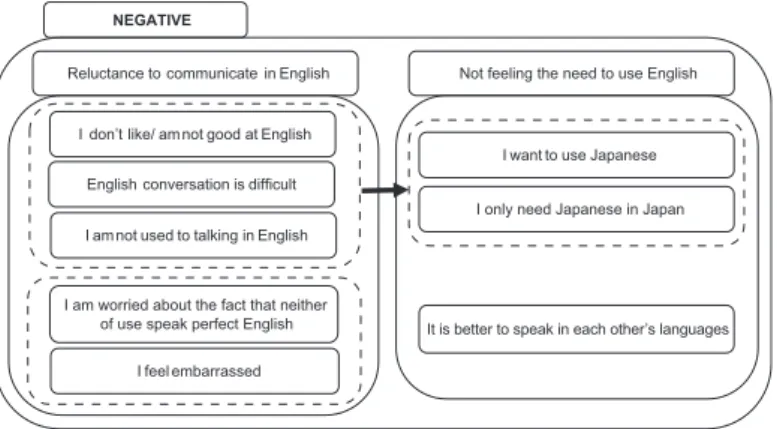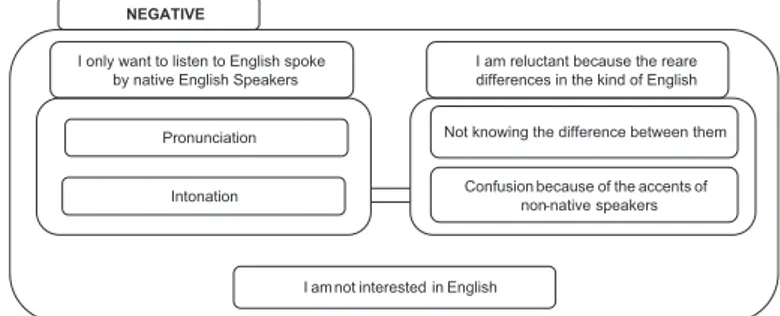Feelings about “Communication with Non-native Speakers”
—From the Open-ended Responses of Japanese
English Language Learners—
Ayami K
ATO1. Introduction
Many visitors have been coming to Japan in recent years. In 2018, the news broadcasted that the number of visitors to Japan broke through the record 30 million mark (JNTO, 2019). At the same time, the number of foreign residents in Japan broke through the 27 million mark; another record (Ministry of Justice, 2019). This can be said to have increased opportunities to come into contact with international people in Japan and to communicate in English which has been established as the international common language. As people from many different countries and regions come to Japan, it is highly possible that the person you are communicating with in English is a non-native speaker whose mother tongue is not English. The purpose of this study is to investigate how Japanese English learners feel about communicating with non-native speakers. Through this kind of investigation, it will be possible to show factors that can be used in teaching EFL to develop some positive attitudes among students towards the communication with non-native speakers.
2. Background
The Japan National Tourism Organization (JNTO) gives a breakdown of the number of visitor arrivals to Japan in 2018 by country or region as shown in Figure 1. Looking at this figure, it can be seen that the majority of people entering Japan are from Asian countries such as China, South Korea and Taiwan. The US is the only native English speaking country from which many visitors come to Japan (JNTO, 2018).
Studies have reported what kinds of inconvenience visitors experience when they visit Japan (Japan Tourism Agency, 2016). Figure 2 shows the results of a questionnaire conducted by the Japan Tourism Agency to visitors to Japan. The questionnaire investigated the problems experienced while travelling and asked about the hosting framework for visitors to Japan.
As this questionnaire dates from 2016, there have already been some major improvements, but looking at this, it can be seen that visitors experienced common problems in various different areas. The most common problem was the ‘Inability to communicate with staff at facilities, etc’ (32.9%). The next common problems were ‘Limited availability of the free Wi-Fi’ (28.7%), ‘Difficulty in understanding, multi-lingual signage’ (23.6%),
Figure 1. Breakdown by Country/Area of Visitor Arrivals to Japan (JNTO, 2018)
Inability to communicate with staff at facilities, etc
Limited availability of the Free Wi-Fi
Difficulty in understanding multi-lingual signage
Using public transport
Exchange
Using Credin/Debit cards
Discount tickets of trains
Rent a mobile hotspot
Purchase a SIM card
Immigration clearance
Making reservation of restaurants and accomodation
Using ATMs 32.9 28.7 23.6 18.4 16.8 13.6 10.6 8.8 7.4 7.4 7.1 6.7 5 0 10 15 20 25 30 35 (%)
Figure 2. Problems Experienced While Travelling in Japan (Japan Tourism Agency, 2016)
and ‘Using public transport’ (18.4%). From these answers, it is obvious that communication is the biggest hurdle in which visitors experience the most inconvenience when they visit Japan. The results in Figure 1 showed that most people who enter the country come from Asian countries, but even it if is possible to cater for the major visitors in Chinese or Korean, it is thought that it would be difficult to maintain signage or service in other Asian languages in all places. Furthermore, in population-dense urban areas such as Tokyo, even if a multi-lingual response is possible, it is difficult and most likely impossible to provide this kind of
service in regional areas due to the difficulty of acquiring and retaining staff.
Kato (2013) conducted a questionnaire among university students about what kind of impressions they have of the English spoken by non-native speakers. Figure 3 shows a summary of the questionnaire results for the question of ‘whether the students want to actively communicate in English with non-native speakers’.
NO, 6%
N/A, 24%
YES, 70%
Figure 3. Whether the Students Want to Actively Communicate in English with Non-native Speakers (n=165)
The results showed that 70% of the 165 university student respondents wanted to actively communicate with them. From this, it can be concluded that many Japanese English learners want to communicate with non-native speakers.
This time we investigated how Japanese English learners feel about communicating with non-native speakers.
3. Methods
The participants of this survey were Japanese university students who were learning English. Specifically, 124 first- and second-year students from the Humanities and Education departments of universities in Aichi Prefecture cooperated with our survey. This study deliberately did not select students from departments and courses that actively include English language study such as English, British and American Culture or British and American Literature. This is because students studying these majors are generally considered to be positive about communicating in English. It should be noted that both male and female students responded to this survey but that we have made no particular distinction between the sexes such as the ratio of male to female.
The survey was conducted in January and February of 2016 and asked the following two questions requiring open-ended answers.
1) Do you want to use English to speak to non-native English speakers?
2) Do you think that it would be useful for you to have opportunities to listen to English spoken by non-native speakers rather than native speakers of English? We categorized the text data to these questions using the KJ Method from Kawakita (1986). It should be noted that the data analysis was conducted by three people, including
the author, and that care was taken so as not to subjectively categorize it.
4. Results and Discussion
4.1 Feelings about communicating in English with non-native speakers
Firstly, the author examined responses of Question 1: Do you want to use English to speak to non-native English speakers? 124 students participated in this survey and one label was assigned for open-ended questionnaire data. That is, if the open-ended questionnaire data contained two ideas they were assigned two labels so the author categorized and analyzed 136 labels.
Figure 4 illustrates and summarizes the results obtained from Question 1. As we used the method of questioning, “Do you want to use English to speak?”, there was potential to roughly divide responses into positive responses using the word ‘want to do’ and negative responses using the phrase ‘do not want to do’.
POSITIVE
NEGATIVE
I feel the convenience of using English I will learn something or
we will learn from eachother
I feel secure when it is two non-native speakers talking together I’m interested in English and
English cultures
Reluctance to communicate in English
Not feeling the need to use English
POSITIVE withFixed Conditions
Environmentally Dependent-Type
Language Skill-Type
Figure 4. Illustrates and Summarizes the Results Obtained from Question 1
Positive responses can be divided into four categories. As there were also some responses that could not be clearly categorized as positive or negative, the author created a ‘Positive category with fixed conditions’ after carefully examining the responses. These included summarized responses which were categorized as ‘Environmentally dependent-type’ and ‘Language skill-dependent-type’. The ‘Environmentally dependent-dependent-type’ categorized responses such as those that depended on whether there was an environment or circumstances in which English had to be used and if they wanted to speak in English. Responses that were categorized into ‘Positive with fixed conditions’ were generally students that showed a positive stance and had a desire to communicate with non-native speakers. However, many students didn’t have any opportunities to speak English or they felt an inadequacy with their language skills which prevented them from communicating.
On the other hand, negative opinions were roughly divided into the two categories of ‘Reluctance to communicate in English’ and ‘Not feeling the need to use English’. Figure 5 extracts the negative categories and divides them into sub-groups.
NEGATIVE
Reluctance tocommunicate in English Not feeling the need to use English
I don’t like/ am not good at English
English conversation is difficult
I am not used to talking in English
I am worried about the fact that neither of use speak perfect English
I feel embarrassed
It is better to speak in each other’s languages I want to use Japanese
I only need Japanese in Japan
Figure 5. Categorization of Negative Factors from Question 1
First of all, there were five sub-groups in the category of reluctance to communicate in English. These five sub-categories were; ‘I don’t like/am not good at English’, ‘English conversation is difficult’, ‘I am not used to talking in English’, ‘I am worried about the fact that neither of us speak perfect English’ and ‘I feel embarrassed’. It is thought that it is possible to categorize the contents of these five into two factors; ‘Feelings of reluctance to use/not being good at English itself’ and ‘Emotional feelings about communication’. The second category of ‘Not feeling the need to use English’ was categorized into three sub-groups. These were; ‘I want to use Japanese’, ‘I only need Japanese in Japan’ and ‘It is better to speak in each other’s languages’, but it is thought that the students meant that it was fine to use only Japanese when they were in Japan. The third sub-group with the opinion that ‘It is better to speak in each other’s languages’ is considered to show that individuals have very positive feelings because it can be interpreted as an intention to respect each other’s languages but it could also be said that they are not positive about communicating in English.
4.2 Discussion of Question 1
The author found out that the category of ‘Reluctance to communicate in English’ included a group that had ‘Feelings about reluctance to use/not being good at English itself’ a group that had emotional reactions such as anxiety or embarrassment. From an instructional aspect it is thought that increasing the frequency of communication in English may be a successful solution. By starting with communication between Japanese people and reducing the reluctance towards communicating in English itself, it is thought that these negative feelings will fade away.
It was also found that the category of ‘Not feeling the need to use English’ included opinions such as thinking that only Japanese is necessary in Japan and it is fine to use each other’s languages. From a pedagogical perspective it may be beneficial to draw out, little by little, positive feelings about communication using approaches other than communication. For example, using activities that introduce not only language but cultural topics. This will give students a broader perspective of intercultural matters, which may lead to developing
motivation for English studies and help students work positively on communicating with people who have a different language or culture to themselves.
4.3 Feelings about listening to the English of non-native speakers
Secondly, the author examined responses for Question 2; Do you think that it would be useful for you to have opportunities to listen to English spoken by non-native speakers rather than speakers of English? Using the same procedure as for Question 1, when creating labels for open-ended questionnaire data, they were assigned one label to one data item so the author categorized and analyzed 147 labels even though there were only 124 answers.
POSITIVE
NEGATIVE
I will learn something or we will learn from eachother
I feel secure when it is two non-native speakers talking together It is possible to communicate with
different people
I only want to listen to English spoken by native English speakers
Fixed Conditions POSITIVE with
Language skill-type
I am aware of differences in English
I am reluctant because there are differences in the kind of English
I am not interested in English
Figure 6. Illustrates and Summarizes the Results Obtained from Question 2
These answers were also categorized into positive and negative in the same way as the previous question (Figure 6). There were four positive categories; ‘It is possible to communicate with different people’, ‘I will learn something or we will learn from each other’, ‘I feel secure when it is two non-native speakers talking together’ and ‘I am aware of differences in English’. This question also had a positive category with fixed conditions and it was named ‘Language skill-type’. This category includes the thought that listening to the English of non-native speakers is useful if the student can understand the English of native speakers.
Figure 7 shows the categorization of negative factors in feelings about listening to the English of non-native speakers.
NEGATIVE
I only want to listen to English spoke by native English Speakers
I am reluctant because the reare differences in the kind of English
I am not interested in English Pronunciation
Intonation
Not knowing the difference between them
Confusion because of the accents of non-native speakers
The negative factors were divided into three categories; ‘I only want to listen to English spoken by native English speakers’, ‘I am reluctant because there are differences in the kind of English’ and ‘I am not interested in English’. The category of ‘I am not interested in English’ was shown separately as it was a negative opinion pertaining to the English language itself. Next, the category of ‘I only need English spoken by native English speakers’ is concentrated around opinions concerning pronunciation and intonation and was categorized into two sub-groups. From this, it can be understood that learners place importance on the aspects of pronunciation and intonation, and that they want to hear the English of native English speakers. On the other hand, resistance to different kinds of English was divided into the two groups based on their knowledge of World Englishes, the groups were ‘Not knowing the difference between them’ and ‘Confusion because of the accents of non-native speakers’. These responses imply reluctance due to difficulties in responding to English that is different to what the student is used to listening to. It can be also seen that the emphasis is placed on English pronunciation in both of these categories.
4.4 Discussion of Question 2
It was found that the category of ‘I only need English spoken by native English speakers’ was made up mostly of opinions that the pronunciation and intonation of native English speakers are necessary. Going face to face with non-native speakers in situations that use English in order to get a positive attitude toward the English spoken by them may yield an advantageous result among English students’ recognition of World Englishes. As it is difficult to create opportunities for direct communication, it is thought to be necessary to innovate by showing videos of non-native speakers in situations using English so that students can actually see it for themselves. The results also showed that resistance to different kinds of English included opinions such as not knowing the differences between types of English and having trouble with the English accents. In such situations, it is thought that it may be useful to, at first, come into contact with various types of English. Students may become more positive about listening to the English of non-native speakers if they know that native speakers also speak very different types of English. An understanding that accent variation exists among native speakers as well as non-native, will further their understanding of various types of English.
5. Conclusion
This research conducted a study on feelings about the communication with non-native speakers. Although learners want to communicate in English, there are some students that have negative opinions and we analyzed the opinions of these students by categorizing them. The results showed what kinds of opinions learners who demonstrated negative factors about communication in English had, and it became clear that they did not have positive thoughts about communicating in English with non-native speakers. With regard to negative factors in feelings held by learners about communicating in English with non-native speakers, it is considered that it is necessary to incorporate, either partially or gradually, educational contents to broaden their knowledge of World Englishes. One thing that was common in the
open-ended questionnaire from students was the strong impression that English is something that is studied at school. It may be necessary to incorporate innovation that provides an awareness of English as a tool used for real-life communication in English classes. Future research will continue to investigate some activities that should be incorporated into English education.
References
Kato, A. (2013). What impression Japanese college students have towards the English spoken by non-native speakers of English? Showa Women’s University Language Education and Communication Studies, 8. Kawakita, J. (1967). “Hassoho” [Abduction]. ChuokoronSha. (in Japanese)
Kawakita, J. (1986). “Zoku Hassoho” [Abduction: Part II]. ChuokoronSha. (in Japanese)
Nakanishi, N. (2011). “Kenkyu no Mokuteki ni awaseta KJ hou no Ouyou” [The Application of the KJ Method for research purposes]. Reports of 2011 Studies in Japan Association for Language Education and Technology,
Kansai Chapter, Methodology Special Interest Groups (SIG) (in Japanese)
Okada, Y. (2018). Japan’s foreign population hitting a record high. Economic Reports, Mizuho Economic Outlook & Analysis Website: https://www.mizuho-ri.co.jp/publication/research/pdf/eo/MEA180913.pdf, (accessed 2020-09-15).
Tanaka, H. (2011). “KJ Hou Nyuumon: Shituteki Data Bunsekihou tosite KJ Hou wo Okonaumaeni” [Introduction of the KJ Method: Before using the KJ Method as a Qualitative Data Analysis]. Reports of 2011 Studies in
Japan Association for Language Education and Technology, Kansai Chapter, Methodology Special Interest Groups (SIG) (in Japanese)
Tanaka, H. (2012). “KJ Hou Quick Manual” [Quick Manual for the KJ Method]. Reports of 2012 Studies in Japan
Association for Language Education and Technology, Kansai Chapter, Methodology Special Interest Groups (SIG) (in Japanese)
Japan National Tourism Organization (JNTO) Website. “Nihon no Kanko Tokei Data” [Japan Tourism Statistics]. https://statistics.jnto.go.jp/graph/#graph--inbound --travelers--transition, (accessed 2020-09-15). (in Japanese) Japan Tourism Agency, MLIT Website. “Honichi Gaikokujin Ryokosha no Kokunai ni okeru Ukeire Kankyo Seibi
ni Kansuru Anketo Kekka” [The Survey Results of Foreign Travelers visiting Japan about the Welcoming Environment]. https://www.mlit.go.jp/ common/001171594.pdf, (accessed 2020-09-15). (in Japanese)




